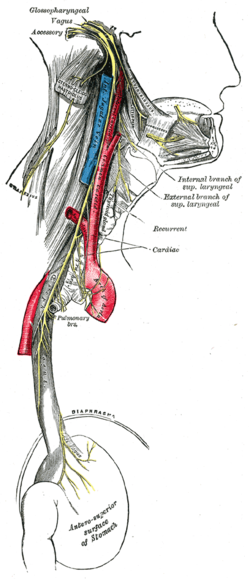Structure and Function of the Superior Laryngeal Nerve
- The superior laryngeal nerve arises from the middle of the inferior ganglion of the vagus nerve.
- It descends by the side of the pharynx deep to the internal carotid artery.
- The nerve divides into two branches: the external laryngeal nerve and the internal laryngeal nerve.
- The external laryngeal nerve descends on the larynx beneath the sternothyroid muscle to supply the cricothyroid muscle.
- The internal laryngeal nerve descends to the thyrohyoid membrane and is distributed to the mucous membrane of the larynx.
- The superior laryngeal nerve innervates the cricothyroid muscle.
Clinical Significance of Superior Laryngeal Nerve
- Damage to the superior laryngeal nerve during thyroidectomy or cricothyrotomy can impair the ability to produce pitched sounds and cause voice fatigability.
- Superior laryngeal nerve palsy can change the pitch of the voice and cause an inability to make explosive sounds.
- Bilateral palsy of the superior laryngeal nerve presents as a tiring and hoarse voice.
- Irritation of the internal laryngeal nerve can result in uncontrolled coughing and an increased risk of aspiration pneumonia.
- An understanding of the anatomy and variations of the external laryngeal nerve is critical for preserving its integrity during surgery.
Additional Image
- The position and relation of the esophagus in the cervical region and in the posterior mediastinum. Seen from behind.
References
- Grays Anatomy, 20th edition, page 912 (public domain text).
- Lasts Anatomy, 12th edition, by Chummy S. Sinnatamby.
- Pain Management Secrets, Third Edition, Chapter 19 - Glossopharyngeal and other Facial Neuralgias, by Robert A. Duarte and Charles E. Argoff.
- World Journal of Surgery, 'Partial superior laryngeal nerve (SLN) lesions before and after thyroid surgery,' by S. Jansson et al.
- Laryngoscope, 'External branch of the superior laryngeal nerve monitoring during thyroid and parathyroid surgery: International Neural Monitoring Study Group standards guideline statement,' by M. Barczyński et al.
The superior laryngeal nerve is a branch of the vagus nerve. It arises from the middle of the inferior ganglion of vagus nerve and additionally also receives a sympathetic branch from the superior cervical ganglion.
| Superior laryngeal nerve | |
|---|---|
 Plan of upper portions of glossopharyngeal nerve, vagus nerve, and accessory nerve. ("Laryngeal" labeled at lower right.) | |
 Course and distribution of the glossopharyngeal, vagus, and accessory nerves. (Branches visible in upper right.) | |
| Details | |
| From | Vagus nerve |
| Innervates | larynx |
| Identifiers | |
| Latin | nervus laryngeus superior |
| TA98 | A14.2.01.160 |
| TA2 | 6339 |
| FMA | 6239 |
| Anatomical terms of neuroanatomy | |
The superior laryngeal nerve produces of two branches: the internal laryngeal nerve (its sensory branch) which supplies sensory fibers to the laryngeal mucosa, and the external laryngeal nerve (its motor branch) which innervates the cricothyroid muscle.
superior laryngeal nerve (plural superior laryngeal nerves)